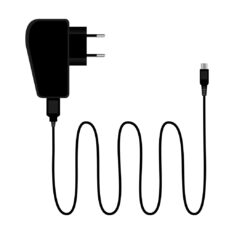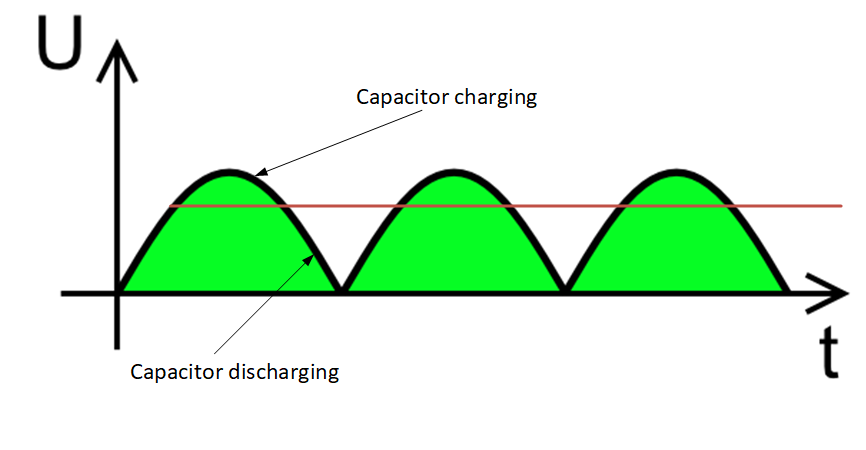
[From the last episode: We looked at the difference between ACAlternating current (which is also alternating voltage). This is how power is delivered to homes and factories. and DCDirect current (which has constant voltage). This is what electronics require as an energy source. powerThe rate of energy consumption. For electricity, it’s measured in watts (W)..]
What comes out of our walls is AC power. In North America, it oscillates at 60 Hz (or 60 cycles per second). In Europe it goes at 50 Hz. Here the nominal (meaning, average or target, since it varies a little) voltage is 110 V; in Europe it’s 220 V. Other parts of the world tend to use one of those two models (although there’s nothing to stop them from doing something yet different).
Our electronics, on the other hand, need DC power. AC power would fry them. They’re not built for the supply voltage ever to go negative. Big no-no. In addition, they need much lower voltagesVoltage is what gets electrons to flow. It's analogous to water pressure, which gets water to flow. Voltage is measured in units of "volts." – like 5 V or less.
So how do we get from one to the other? That’s the role of those bricks we plug into the wall for all of our gadgets. Those do two things: convert the wall AC to DC and lower the voltage. Today we’re going to talk about the first of those.
Eliminate the Negative
The first big issue with AC is the fact that it goes negative. We have to get rid of that negative portion. We can do that with the assistance of something called a diodeAn electrical component that allows current in one direction but blocks it in the other direction.. This is a really old kind of device that even existed back in the days of tubes. It was just a lot bigger then than it is today.
A diode does one thing: it allows currentThe amount of electrical flow. Measured in amperes or amps (A). in one direction and blocks it in the other. The symbol for a diode is shown below. It “points” in the direction that allows current flow.
![]()
If we hook that up to the power, then, when it’s positive, the current can flow. But when the voltage goes negative, the current wants to flow in the opposite direction – and it can’t. So you simply get nothing. That gives something that looks like the next image: you keep the positive part and then lose the negative part.

Modified from Wdwd – Own work, CC BY 3.0, https://commons.wikimedia.org/w/index.php?curid=12693362
If you want a fancy name for this, it’s called rectificationThe process of eliminating or transforming the negative parts of an AC signal or power.. In particular, what we’ve seen so far is half-wave rectification since you get only the positive bits and nothing in between. Which isn’t very satisfying – we’re wasting half of what’s happening. Instead, we can use a fancier circuit (I’m not showing circuits because it’s more detail than we need) and do full-wave rectification. It’s like we take the negative parts and flip them over to the positive side.

Modified from Wdwd – Own work, CC BY 3.0, https://commons.wikimedia.org/w/index.php?curid=12693353
Smoothing it Out
That’s a whole lot better. But it’s still not really DC. We need to smooth those bumps out to get something that’s level. Conceptually, we can do that with a capacitorCapacitance is the ability of an electron or hole to “feel” other electrons or holes on the other side of a small gap. The gap prevents actual current from flowing, but, if small enough, electrons and holes can pile up on either side of the gap. Specific devices that make use of this are called capacitors.. A capacitor is simply a component that stores charge. You can put charge on it, and then take charge off of it. So if we use the positive peaks to store charge, then, when we get to the lower parts of the bumps, the capacitor can let go of some of the charge to make up the difference.

Basically, we store it when we can, and, when we drop, the capacitor fills in the gap. To do a really good job of this, of course, we need a much more sophisticated circuit, and we don’t need those details. But this fundamentally explains how we can turn AC power into DC power.
Of course… if the peaks are at 110 V, then we’re getting, well, not 110 V DC (see the red line above), but a lot more than 5 V! That’s still a problem. And that’s what we’ll talk about next week: moving from one voltage to another.

Leave a Reply